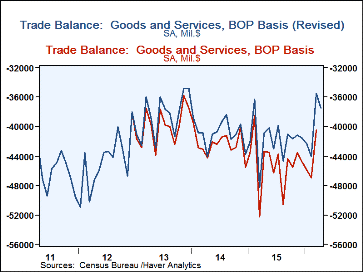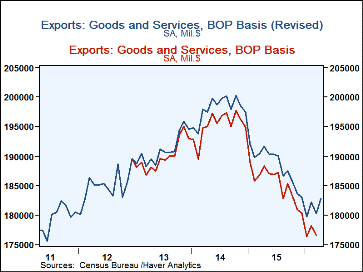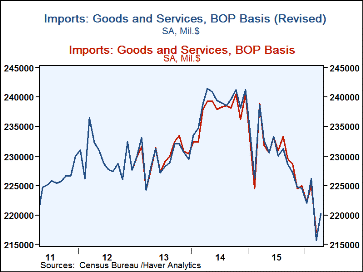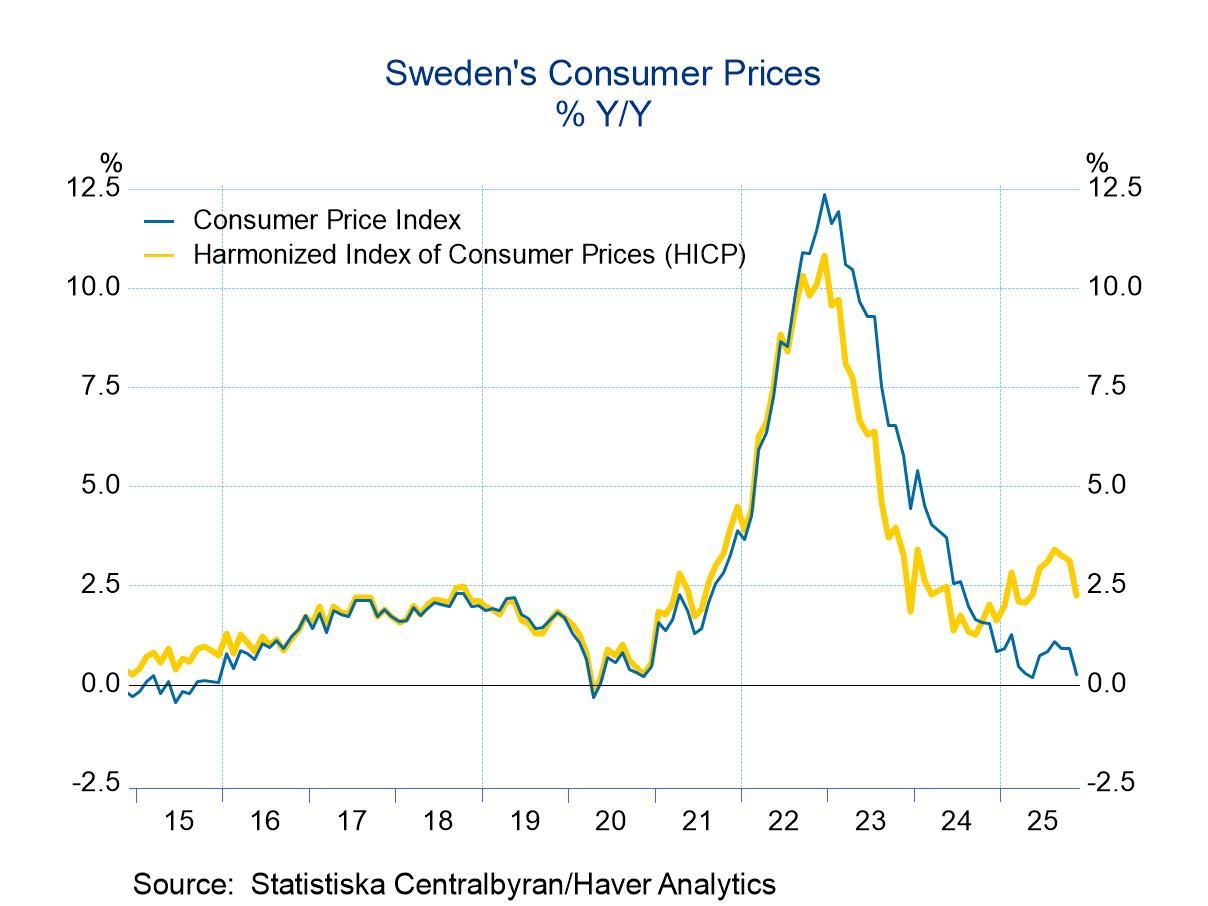 Global| Jun 03 2016
Global| Jun 03 2016April US Trade Deficit Widens with Increases in Both Exports and Imports
by:Sandy Batten
|in:Economy in Brief
Summary
The U.S. trade deficit in goods and services widened to $37.4 billion in April from a revised $35.5 billion in March. The Action Economics Forecast Survey had expected a $42.0 billion deficit billion. While this outcome would appear [...]
The U.S. trade deficit in goods and services widened to $37.4 billion in April from a revised $35.5 billion in March. The Action Economics Forecast Survey had expected a $42.0 billion deficit billion. While this outcome would appear to be much better than expected, it was significantly impacted by benchmark revisions. Compared to the pre-revision March reading ($40.4 billion), the consensus was looking for a $1.6 billion widening of the deficit in April. In the event (that is, after revisions), the deficit widened by $1.9 billion in April. Both exports and imports rose in April, reversing their March declines. Exports were up 1.5% m/m in April after a revised 1.1% m/m drop in March. The import rebound in April was sharper with imports rising 2.1% m/m following a revised 4.6% m/m decline in March.
The highlight of the April report was the benchmark revisions that extended back to January 2013. Every monthly revision to the goods and services trade balance was positive, that is, a smaller deficit than previously reported. On average, the revision to the trade deficit was $2.2 billion; that is, the revised trade deficit on average was $2.2 billion per month smaller than previously reported. The source of the revisions was mainly exports. Again, every monthly revision to exports was positive, averaging a $2.5 billion increase per month across both goods and services. Revisions to imports were significantly smaller and were both positive and negative, averaging only $0.3 billion per month. These revisions should reduce the drag from trade that has been evident in the GDP figures.
In the details, the goods deficit increased $1.4 billion to $58.8 billion in April while the services surplus slipped $0.5 billion to $21.4 billion. Goods exports were up 2.5% m/m in April, slightly outpacing the 2.4% m/m rise in goods imports. Both goods exports and imports in April were stronger across all end-use categories except the catch-all "Other". Petroleum imports jumped 5.7% m/m in April, more than reversing their 3.9% m/m decline in March; nonpetroleum imports also rose in April (2.3% m/m) but failed to offset their 5.7% m/m drop in March. Exports of services slipped 0.4%m/m in April while imports of services edged up 0.7% m/m. The decline in services exports was widely spread while the increase in services imports was concentrated in "Transport".
By country, the trade deficit with China ($26.6 billion) was little changed in April from March, while the deficits with the European Union ($11.8 billion) and with Japan ($6.0 billion) widened slightly in April.
The international trade data can be found in Haver's USECON database. Detailed figures are available in the USINT database. The expectations figures are from the Action Economics Forecast Survey, which is carried in the AS1REPNA.
| Foreign Trade in Goods & Services (Current Dollars) | Apr | Mar | Feb | Y/Y | 2015 | 2014 | 2013 |
|---|---|---|---|---|---|---|---|
| U.S. Trade Deficit | $37.4 bil. | $35.5 bil. | $44.0 bil. | $40.9 bil. (4/15) |
$500.4 bil. | $490.2 bil. | $461.9 bil. |
| Exports of Goods & Services (% Chg) | 1.5 | -1.1 | 1.3 | -4.6 | -4.9 | 3.6 | 3.4 |
| Imports of Goods & Services (% Chg) | 2.1 | -4.6 | 1.8 | -5.3 | -3.7 | 4.0 | 0.0 |
| Petroleum (% Chg) | 5.7 | -3.9 | -10.5 | -34.3 | -45.5 | -9.6 | -11.0 |
| Nonpetroleum (% Chg) | 2.3 | -5.7 | 3.0 | -4.2 | 2.2 | 6.5 | 2.0 |
Sandy Batten
AuthorMore in Author Profile »Sandy Batten has more than 30 years of experience analyzing industrial economies and financial markets and a wide range of experience across the financial services sector, government, and academia. Before joining Haver Analytics, Sandy was a Vice President and Senior Economist at Citibank; Senior Credit Market Analyst at CDC Investment Management, Managing Director at Bear Stearns, and Executive Director at JPMorgan. In 2008, Sandy was named the most accurate US forecaster by the National Association for Business Economics. He is a member of the New York Forecasters Club, NABE, and the American Economic Association. Prior to his time in the financial services sector, Sandy was a Research Officer at the Federal Reserve Bank of St. Louis, Senior Staff Economist on the President’s Council of Economic Advisors, Deputy Assistant Secretary for Economic Policy at the US Treasury, and Economist at the International Monetary Fund. Sandy has taught economics at St. Louis University, Denison University, and Muskingun College. He has published numerous peer-reviewed articles in a wide range of academic publications. He has a B.A. in economics from the University of Richmond and a M.A. and Ph.D. in economics from The Ohio State University.










